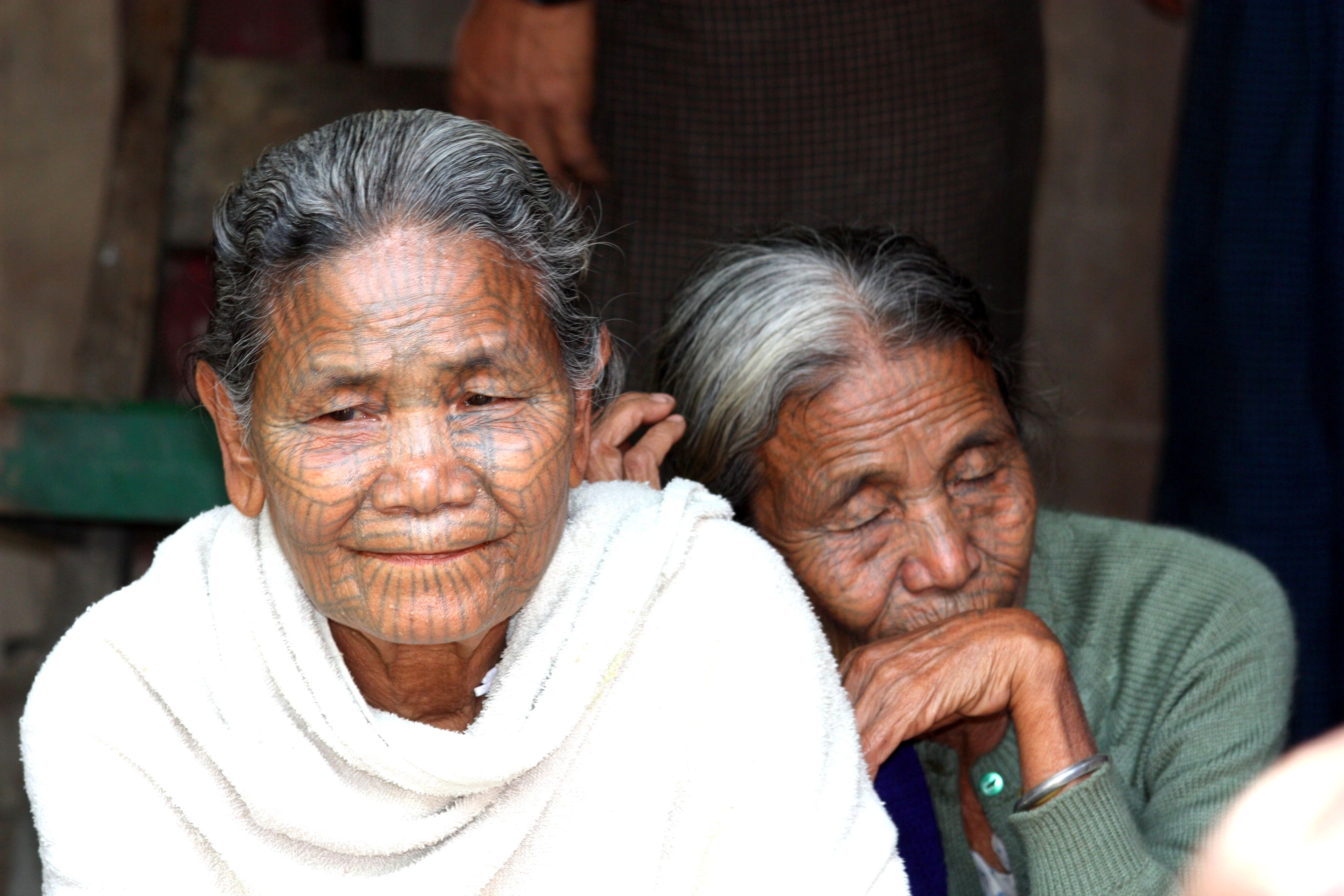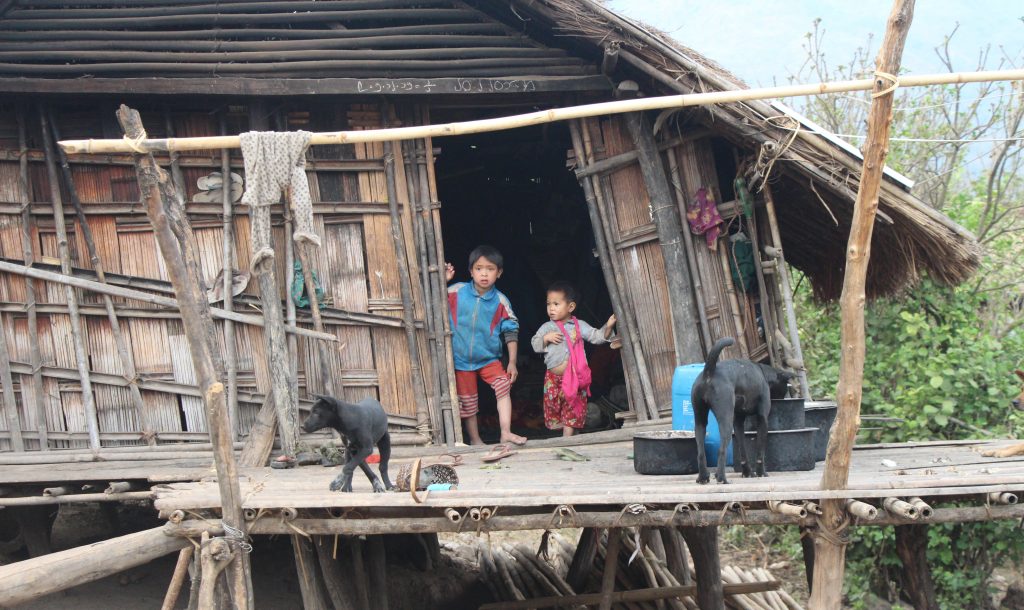Burning lands and fragile livelihoods in the hills of Myanmar’s southern Chin State.
Everywhere you look in Myanmar’s isolated southern Chin State in March, the landscape is burning. The crisp morning air quickly turns acrid and smoke fills the valleys, obscuring the impressive peaks of the Arakan Mountains that extend northwest over the border into India. At night, thin lines of orange flame extend off into the horizon, like fiery necklaces draped over the slopes below.
Fire is an essential part of the agro-ecological landscape in Chin state. The Chin people, known for the traditional facial tattoos that adorn older Chin women, are predominantly shifting cultivators. Leading up to the rainy season, farmers set fire to the forest to clear and prepare a new patch of land for planting crops of mostly millet, maize and upland rice varieties.
After harvest, the land is left to regenerate for five to 10 years, as farmers move on to a new patch of land to repeat the process. Agriculture here is extremely low input. The lack of flat land makes the use of draught animals difficult, and households lack access to fertilisers and irrigation. In fact, in most cases the only input is the labour of the farming household.
While shifting cultivation is deeply integrated into the daily experiences of Chin households, farmers here face increasing economic and ecological challenges in improving the livelihoods and food security of their households — particularly in the context of ongoing reforms in the wider Myanmar economy. The hilly terrain, poor soils and lack of irrigation mean that agriculture is often a precarious pursuit, and limited to grain crops of low nutritional value.
Households generally rely on shifting cultivation to survive, consuming all of what they grow and supplementing their diets with domesticated and wild meat, or, when assets allow, occasional purchases of rice and vegetables from markets in the Bamar lowlands below. Dietary diversity, an important indicator of food and nutrition security, is generally sub-par as households either cannot grow or lack access to vegetables and fruits.
Chin households also lack access to other important assets, such as cash, credit, education and transport infrastructure, constraining their livelihood decisions. Most households have very little material possessions, and are not regular participants in the cash economy. When a crop surplus is produced, the isolation of Chin villages and poor infrastructure produces another set of challenges in accessing markets to sell their crops.
In Kanpetlet township, many villages are only accessible by motorbike along steep and narrow mountain tracks. Given that motorbike ownership is limited, villagers (usually women) must walk for up to one day to reach the nearest market.
How, then, are rural Chin households responding to these pressures, and what might future rural landscapes in Chin state look like? Which households will prosper and which will be left behind in the new Myanmar?
Adopting a livelihoods approach can shed critical light on these questions. Sustainable livelihoods analysis is a multidisciplinary approach that examines the concrete and different ways that local people construct their ways of living, and the capabilities and constraints that influence the ability of different households to pursue different livelihood pathways. Importantly, the livelihoods approach starts at the micro-level, emphasising the contextual realities within which rural people live their lives.
This approach allows livelihoods researchers to understand the broad, and context-dependent, range of factors that influence livelihood decision-making. An important insight of the livelihoods approach is that livelihood decisions are influenced by and depend on access to a range of assets and capabilities (social, human, natural, political) beyond the economic realm.
So, while mainstream economic analyses of rural economies often conceptualise rural households as rational, autonomous, utility-maximising actors, rural Chin households are making livelihood decisions for a range of reasons that cannot be explained by economic theory alone. Often, trade-offs are made between food security/production and other cultural and social practices that are important to the fabric of Chin society.

Tattooed women in southern Chin State. Photo: Daniel Julie/Wikimedia
The production of Khaung-yay, a locally brewed alcohol, is a prime example. While access to good quality cropland is increasingly difficult, most rural households in southern Chin will dedicate a significant portion of land each season to millet for the production of Khaung-yay. The intoxicating brew, reminiscent of Japanese sake, is an integral part of local festivals and marriages, and plays a vital role in the local exchange economy. Khaung-yay also represents one of the few opportunities for Chin women to earn cash income by trading with nearby villages.
A livelihood lens also emphasises the role of livelihood diversification in southern Chin. While shifting cultivation continues to be central to the livelihoods of most rural Chin households, the shrinking land frontier and increasing ecological pressures on the land base, and the impact of a number of shocks in recent years (including a calamitous rodent infestation in 2010, and devastating flooding and landslides in 2015) highlight the vulnerability of agricultural livelihoods in the area. In response, households attempt to diversify their livelihood base.
However, local non-agricultural livelihood opportunities are limited. As a result, migration, both temporary and permanent, to find work is increasing. A common migration pathway for (usually male) household members is to Malaysia overland through Thailand to find construction or farm labouring work, joining the growing number of undocumented Myanmar workers there.
For some, migration represents opportunities to accumulate wealth. In one village in Kanpetlet township, around 10 households with a member in Malaysia sending home remittances had been able to construct new houses made of solid pine. Importantly, however, rural households do not enter the non-agricultural economy on a level playing field.
Those households who have already accumulated some wealth can access more lucrative opportunities, furthering their advantage. Those with constrained access to livelihood assets, such as education, social networks and credit, face the same struggles in the non-agricultural economy as in farming. In several villages, entire households have been forced to leave their villages (‘distress migration’) to seek a better life, increasing pressure on the social fabric and resilience of local communities. For these households, their poverty is often simply transferred from rural to urban spaces.
What can the insights revealed by a livelihoods approach bring to rural development policy? At this critical point in the economic development of Myanmar, a narrative of market-led development has emerged that envisions a modern, liberalised commercial agricultural sector articulated into the global economy through foreign investment and export-focused global value chains. This markets plus approach imagines a homogenous landscape of entrepreneurial farmers only held back by market failures and the distorting policies of state intervention. One policy implication of this ‘inclusive market development’ approach is the promotion of contract farming as a way to encourage links between the private sector and small farmers.
However, in southern Chin state, putting all eggs in a markets plus basket appears unsuited to the livelihood realities of rural households. While proponents of market-led approaches often promote a ‘win-win’ narrative, such an approach will inevitably lead to the uneven production of winners and losers.
A good illustration of this in the context of southern Chin state is land tenure. In remote villages in Kanpetlet and Mindat township, land is commonly collectively owned by the village, and access is negotiated and coordinated through the local village council. These local institutions of land access have evolved over time to suit existing livelihood practices and local agro-ecological realities. In several villages we visited, there was little concept of private ownership of land, and villagers resisted the idea of a system of fixed, individually owned farms like that practiced by the Bamar people in neighbouring Magway region.
However, closer to the main towns, where capital investment in fixed-land rice farming, infrastructure and market access is growing more rapidly, private land-ownership is increasing. This creates the conditions for accumulation of land and, therefore, socio-economic differentiation. As land ownership is privatised, wealthy entrepreneurial farmers emerge at the expense of their neighbours, who must compete for resources including land, capital and labour. Encouraging private-ownership land tenure systems, a key part of the ‘enabling environment’ required for market-led development, without a critical understanding of the local political economy of land may exacerbate existing inequalities in rural Chin villages, leading to loss of land access for some, and provide benefits to only a select group of already better-off households.
Instead of privileging an idealised notion of market-led development, a more appropriate approach for rural development policy in Chin state is to confront the realities of real markets in all their diversity. This involves understanding the actual ways in which rural Chin households engage in market and non-market activities to sustain their livelihoods. Importantly, this acknowledges that different households and individuals engage in livelihoods from very different and unequal social locations, influenced by relationships of class and power, and control over livelihood assets. Such an approach also avoids wholly associating rural development with agricultural development.
Articulation into export crop value chains may be an important and viable livelihood pathway for some Chin households able to secure private rights over quality land. However, other households will more and more depend on access to rural and urban non-agricultural labour markets, while others will continue to engage in shifting cultivation and migration/remittance pathways. Engaging with real markets also emphasises the continuing importance of the role of the Myanmar state in rural development outcomes.
Rather than vacating space for uncritical private-sector led development, rural development policy should focus on building a broad range of livelihood assets and capabilities for Chin households, and challenging the structures that lead to their uneven distribution, so that rural Chin people are able to make appropriate livelihood decisions that fit with both their long-held traditions and hopes for the future.
Mark Vicol is a Postdoctoral Research Associate in the School of Geosciences at the University of Sydney. This article reports some preliminary insights from fieldwork conducted in southern Chin State in March 2016, as part of a larger ARC-funded research project investigating the links between livelihood pathways and food and nutrition security in Myanmar (led by the University of Sydney and University of Western Australia).
 Facebook
Facebook  Twitter
Twitter  Soundcloud
Soundcloud  Youtube
Youtube  Rss
Rss 